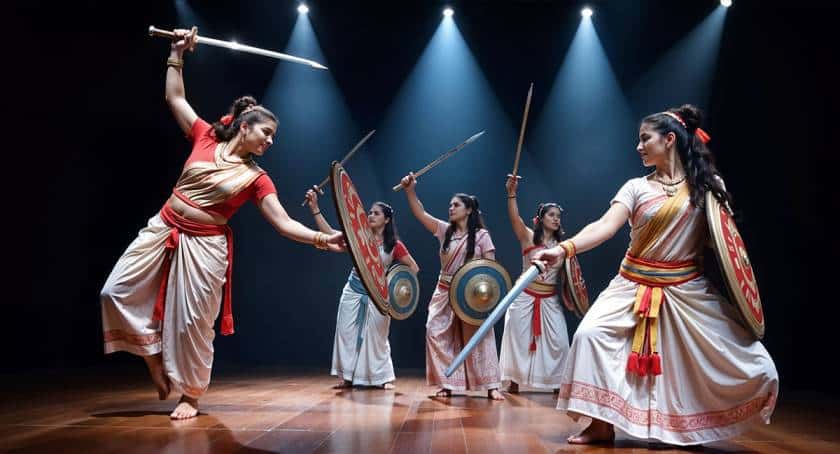Paika Akhada – Forging Warriors for Generations!
Odisha, a state rich in heritage of culture and historical traditions, is home to many art forms and martial practices. Among them, Paika Akhada holds a special place. The term ‘Paika’ refers to the warrior class of Odisha, while ‘Akhada’ signifies a traditional training ground. Paika Akhada is not just a martial art form but a symbol of valor, discipline, and resistance against colonial rule. This blog examines Paika Akhada’s cultural relevance, training techniques, and historical significance in the modern era.
Origins and Historical Background of Paika Akhada
Paika Akhada originated in the 16th century, during the reign of the Gajapati kings of Odisha. The Paikas were the traditional militia who served as warriors under the kings, protecting the kingdom from invaders. This warrior class was known for its exceptional combat skills, including swords, shields, spears, and even unarmed combat techniques.
One of the most significant events associated with Paika warriors was the Paika Rebellion of 1817. This was one of the earliest uprisings against British colonial rule in India. Under the leadership of Bakshi Jagabandhu, the Paikas revolted against the British East India Company, showcasing their military prowess. Though eventually suppressed, the rebellion remains an inspiring chapter in India’s fight for freedom.
The British, fearing the strength and influence of the Paikas, dismantled their training centers and weakened their socio-political status. However, despite colonial suppression, Paika Akhada survived as a cultural tradition and continued to be practiced in various parts of Odisha.
Training and Techniques of Paika Akhada
It is more than just a martial art. It is a structured training system that involves physical fitness, agility, weapon training, and mental discipline. Experienced mentors, known as Paikas, guide students as they learn in open spaces or traditional akharas
Physical Conditioning:
Physical fitness is the foundation of Paika Akhada. The training includes:
- Running and jumping to improve stamina and agility.
- Push-ups, Squats, and Yoga for overall body strength.
- Flexibility exercises to enhance movement efficiency.
- Balancing and Coordination drills to perfect combat maneuvers.
These exercises prepare the practitioners for the rigorous demands of hand-to-hand combat and weapon handling.
Weapon Training:
Paika warriors were experts in handling various weapons. The key weapons used in training include:
- Khanda (Sword): Practitioners learn offensive and defensive techniques using a sword. Swordplay involves swift strikes, parries, and counter-attacks.
- Shield Combat: Warriors train to block and counter enemy strikes using a shield, often in combination with a sword or a spear.
- Spear Fighting: Spear techniques involve attacking and parrying moves, essential for individual and group combat.
- Staff Fighting (Lathi): Stick fighting techniques are also incorporated for self-defense. It involves quick movements, spinning techniques, and targeted strikes.
- Dagger Combat: Short-range weapon combat using daggers is also integral to the training, especially for close-quarter fights.
Unarmed Combat:
Apart from weapons, Paika Akhada also includes hand-to-hand combat techniques like:
- Wrestling and grappling to neutralize opponents.
- Traditional Kusti and Kalari movements inspire punches and kicks.
- Defensive techniques to block or counter an opponent’s attack.
Unarmed combat is crucial in preparing warriors for situations where they might lose their weapons in battle.
Cultural Tradition
It is a martial art and a vibrant cultural tradition in Odisha. People perform it during festivals like Dussehra, Holi, and Pana Sankranti. These performances include sword fights, acrobatics, and synchronized group formations, showcasing the warriors’ skill and discipline.
The traditional war cry and drum beats create an electrifying atmosphere during these performances, bringing history alive. Many villages in Odisha still have active Paika Akhadas, where young boys and men continue to learn and preserve this ancient tradition.
Additionally, martial arts are often performed during wedding processions, temple festivals, and community gatherings, symbolizing strength, protection, and valor.
Popular Culture
Films, documentaries, and literature also showcase the influence of Paika Akhada. Several Odia and national filmmakers have depicted the Paikas’ courage and combat skills in their work. Researchers and historians are also exploring its impact on India’s freedom movement, further solidifying its historical place.
The Odisha government and cultural organizations are trying to preserve and promote this martial tradition. Recently, initiatives have been taken to integrate Paika Akhada training into school curricula and hold public demonstrations to generate interest among younger generations.
Final Thoughts
It is not just an art of warfare but a symbol of Odisha’s bravery, discipline, and resistance. This martial tradition, rooted in the history of the Gajapati kings and the heroic Paika Rebellion of 1817, continues to inspire generations. Whether as a form of self-defense, a performance art, or a historical legacy, Paika Akhada is evidence of Odisha’s warrior spirit.
Ancient martial arts must be acknowledged and preserved for their historical value and contribution to discipline, physical fitness, and cultural pride. Thanks to Paika Akhada, which has strong roots in Odisha’s past and acts as a link between the past and present, the spirit of the Paika warriors will endure for future generations


